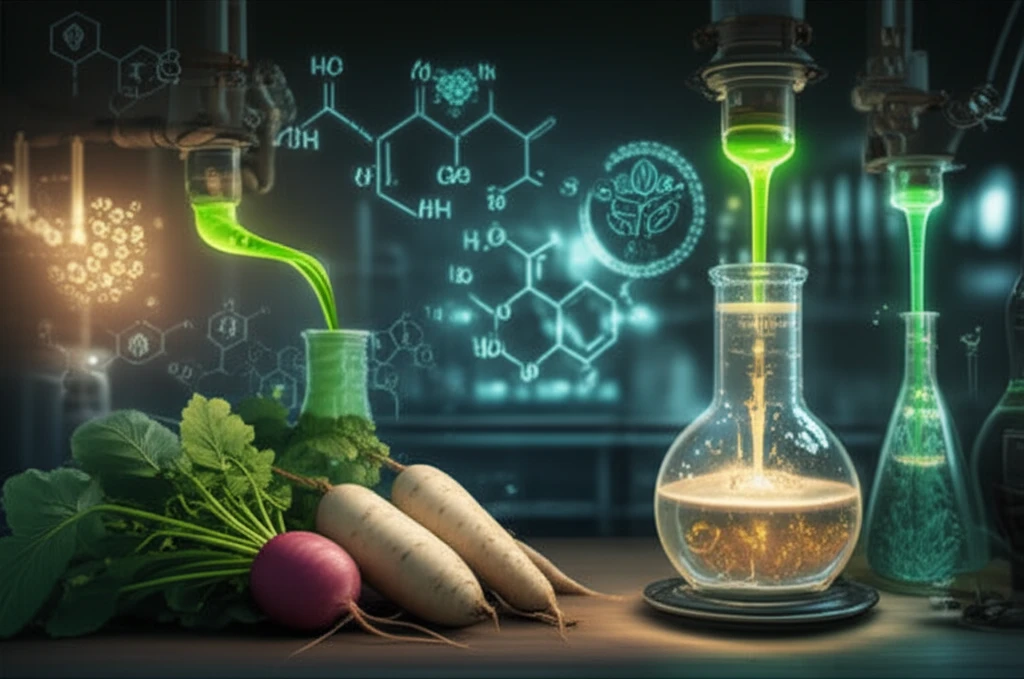
Unlocking Nature's Potential: How Radish and Turnip Enzymes are Revolutionizing Chemical Processes
"Discover how humble vegetables are leading the charge in sustainable and efficient chemical reactions, offering a greener alternative to traditional methods."
In the quest for sustainable and environmentally conscious chemical processes, scientists are increasingly turning to nature for inspiration. Enzymes, biological catalysts produced by living organisms, offer a powerful alternative to traditional chemical catalysts, often reducing harsh conditions and minimizing waste. Among these natural catalysts, peroxidases, enzymes found in plants and microorganisms, are gaining prominence for their ability to facilitate a wide range of chemical reactions.
Peroxidases (PODs) are heme proteins, meaning they contain an iron-containing porphyrin ring, which are involved in oxidation reactions using hydrogen peroxide (H2O2) or organic peroxides as terminal oxidants. While horseradish peroxidase (HRP) is perhaps the most well-known and commercially available peroxidase, researchers are exploring other sources of these versatile enzymes, particularly from common vegetables like radishes and turnips.
This article delves into a fascinating study exploring the use of peroxidases extracted from radishes (Raphanus sativus L.) and turnips (Brassica napus L.) to catalyze the epoxidation of isosafrol, a chemical compound used in the flavor and fragrance industries. We'll uncover how these humble vegetables can be harnessed to drive sustainable chemical transformations, offering a glimpse into the future of green chemistry.
Radish and Turnip Enzymes: A Sustainable Catalyst for Chemical Reactions?

The study focuses on extracting peroxidases (PODs) from radishes and turnips using a simple and cost-effective method involving ammonium sulfate precipitation. This process allows researchers to isolate and concentrate the enzymes from the vegetable extracts. The activity of the extracted PODs is then assessed using a guaiacol assay, a standard method for measuring peroxidase activity.
- Effective Extraction: A simple ammonium sulfate precipitation method successfully extracted peroxidases from both radishes and turnips.
- Isosafrol Epoxidation: Radish and turnip peroxidases effectively catalyzed the epoxidation of isosafrol in a 20% aqueous ethanol solution, using hydrogen peroxide as the terminal oxidant.
- High Conversion and Selectivity: Radish peroxidase exhibited high conversion rates (88%) and excellent selectivity (>98%) for the epoxide product.
- Product Analysis: High-resolution gas chromatography and mass spectrometry confirmed the formation of the epoxide product.
The Future of Green Chemistry: Harnessing the Power of Plant Enzymes
This research showcases the potential of using readily available plant enzymes, specifically peroxidases from radishes and turnips, as sustainable catalysts for chemical reactions. By harnessing the power of nature, we can move towards greener and more environmentally friendly chemical processes, reducing our reliance on harsh chemicals and energy-intensive methods.
The study's findings open doors for further exploration of plant-derived enzymes in various chemical applications. Future research could focus on optimizing enzyme extraction and purification methods, improving enzyme stability and activity, and expanding the range of chemical reactions catalyzed by these versatile biocatalysts.
As the demand for sustainable and environmentally responsible chemical processes continues to grow, plant enzymes like radish and turnip peroxidases are poised to play a significant role in shaping the future of green chemistry. This innovative approach offers a promising path towards a more sustainable and environmentally conscious chemical industry.
